| The
Flash Interface
Before you can begin to create interactive animations
in Flash you need to become familiar with the working environment.
Step 1:
Open Flash MX
The document window you will see contains six major elements: the
Timeline; the Stage;
the Work Area; the Information
Bar; the Toolbox; and the Panels |
 |
The Timeline

- The
Timeline controls and shows all of the
elements of your project over time. It uses Frames and Layers to organize
your work.
- The
Playhead tells you which frame is currently
displayed on the Stage
Layer controls allows you to control your layers.
You will learn about layers in more detail later in this tutorial
- Status
Bar gives you information about the current frame, the number
of frames per second (fps) and the elapsed time of your movie
- The Frame
View is a drop down menu that lets you control the appearance
of the Timeline.
Layers
allow you to organize your work.
- Layer
name - the default
is Layer 1, Layer 2 etc
- Insert
layer - click
to add a new layer
- Add
motion guide
- by clicking this you add a guide layer on top of your current
one
- Insert
Layer Folder
- this adds a folder that can store other layers, this is useful
in complicated projects to help organize your work
- Delete
Layer - to remove
a layer, drag it to the trash
Show/Hide all layers - can hide a
layer while you are working
- Lock/unlock
all Layers -
by clicking this it's impossible to edit a layer
- Outline
view - displays
solid shapes as outlines with no fill
|
Layer Controls
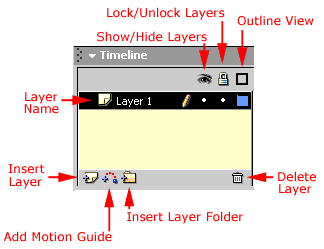 |
The Information Bar

The purpose of the Information
Bar is to give you quick visual feedback about where you
are in your movie.
- Current
Scene - displays the
name of the scene currently open on the Stage
- Edit Scene
Menu - is a drop down
menu that shows all the scenes in your project file
- Edit Symbol
Menu - again is a drop
down menu. This shows all the symbols in your project
- Zoom
- a drop down menu that allows you to zoom in or out of the contents
of your stage
Panels
are windows that contain the tools and information you will need
to work on your project files. Each of the panels is used to view
and change things in your work.
This tutorial will introduce you to some of the basic features
of the panels, but detailed information will be presented throughout
the semester as you progress through all the tutorials in learning
Flash MX basics.
Panels can be arranged in defined Panel Sets.
The default set includes: Color Mixer;
Color Swatches; Components;
and Answers
|
The Window Menu
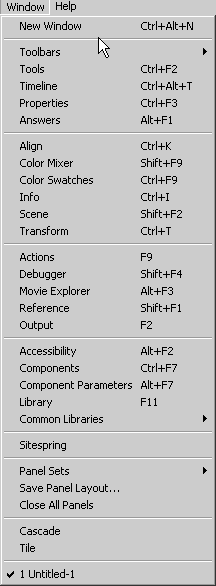
|
Scene
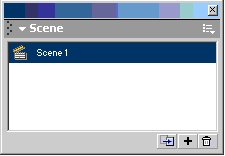
Scene displays
a list of all the scenes in your movie. You can add, delete, duplicate,
name, or rename scenes in this panel |
Transform
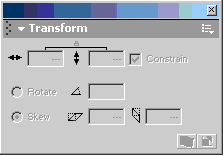
The Transform
panel allows you to rotate, scale and skew an object numerically |
Align
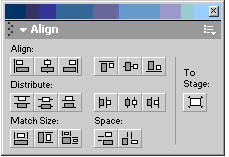
The Align
panel allows you to align objects |
Info

The Info
panel gives you numerical information about the size, position and
color of the selected object. |
Accessibility
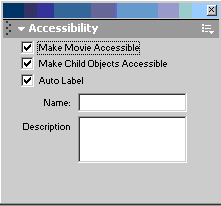
Accessibility
gives you some options to make your movie accessible to the disabled.
This is extremely important for professionals having to meet EU guidelines |
Library

The Library
is a location for you to store symbols, imported artwork, sound files
and video files. |
Common Library Buttons
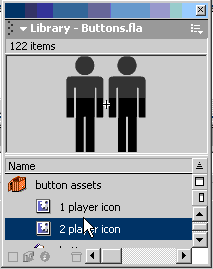 |
Common Library Learning
Interactions
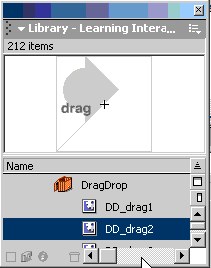 |
Common Library Sounds
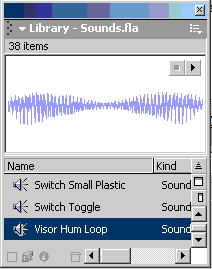 |
| Common
Libaries exist for
some basic buttons, interactions, and sounds. |
Movie Explorer

Movie Explorer
shows the contents of your movie in a hierarchical tree |
Output

Output
gives you assistance during troubleshooting by giving you feedback |
Debugger
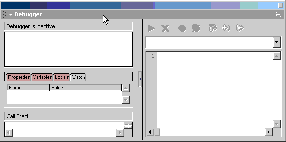
The Debugger
gives you a way to check your movie for errors while it's playing
in the Flash Player |
Actions
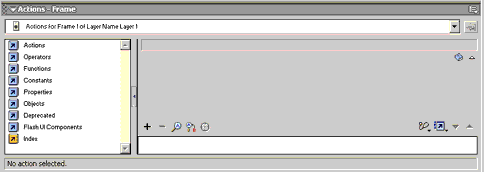 |
The Actions
Panel allows you to add and change actions for a frame, button
or movie clip |
Reference
 |
The Reference
Panel shows you detailed information about ActionScripting
use and syntax |
Property Inspector

The Property
Inspector displays and allows changing of all the commonly used attributes
of the currently selection in one panel. This saves you time, in that you
don't have to open multiple panels to make a change
All panels can be Expanded, Collapsed, Hidden, Closed
or Resized
Flash
Interface | Flash Tools | Flash
Animation | Tweening | Symbols/Instances
| Buttons
|




